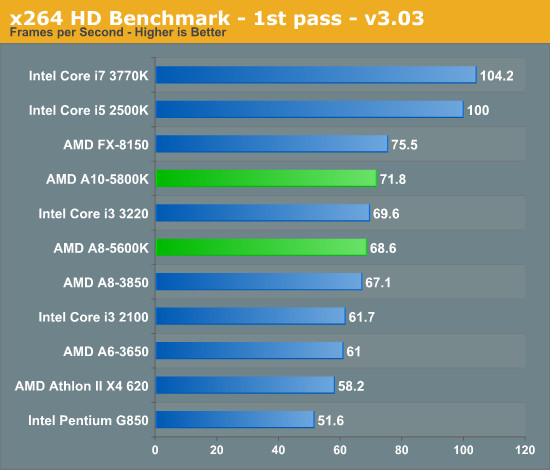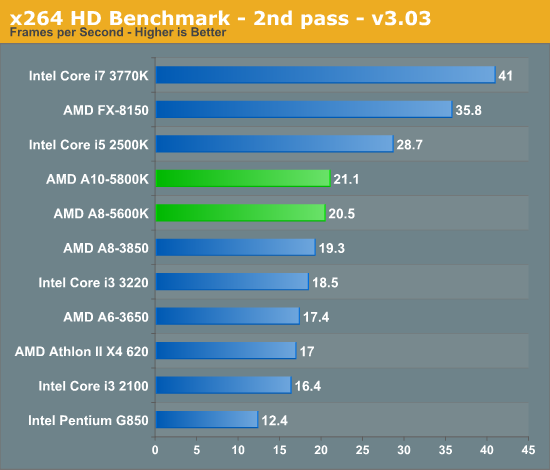AMD A10-5800K & A8-5600K Review: Trinity on the Desktop, Part 2
by Anand Lal Shimpi on October 2, 2012 1:45 AM ESTVideo Transcoding Performance
x264 HD 3.03 Benchmark
Graysky's x264 HD test uses x264 to encode a 4Mbps 720p MPEG-2 source. The focus here is on quality rather than speed, thus the benchmark uses a 2-pass encode and reports the average frame rate in each pass.


CPU based video transcode performance is as good as it can get from AMD here given the 2/4 module/core setup of these Trinity APUs. Intel's Core i3 3220 is a bit slower than the A10-5800K. We're switching to a much newer version of the x264 HD benchmark for our new test suite (5.0.1). Some early results are below if you want to see how things change under the new test:
| x264 HD 5.0.1 Benchmark | ||||
| 1st Pass | 2nd Pass | |||
| AMD A10-5800K (3.8GHz) | 33.5 fps | 7.41 fps | ||
| AMD A8-5600K (3.6GHz) | 32.2 fps | 7.12 fps | ||
| Intel Core i3 3220 (3.3GHz) | 35.2 fps | 6.61 fps | ||










178 Comments
View All Comments
jamyryals - Tuesday, October 2, 2012 - link
On the whole, mainstream consumers do not use desktop PCs. They use laptops.Beenthere - Tuesday, October 2, 2012 - link
Sorry but your beliefs on laptop vs. desktop usage is incorrect. While a lot of young people, sales people etc. use laptops, the split is almost 50/50 according to a recent survey, meaning that ~50% of PC users still use desktops.That being said, Trinity laptop is by far the best choice for mainstream consumers who prefer a laptop over a desktop.
Either way it's a win for AMD and consumers on the desktop or for a laptop. Servers will be next as the AMD APUs have shown excellent results for servers even though they were never intended for same.
silverblue - Tuesday, October 2, 2012 - link
No, but Trinity sports a CPU architecture slanted towards servers. It's not such a strange idea in the end.BSMonitor - Tuesday, October 2, 2012 - link
Could it simply be the priorities of the target customers that so greatly affect how Intel approaches the markets and SKU's??It seems like it would be very easy to grow the die and throw 24-32 EU's on the iGPU side of things. However, what portion of their vast corporate PC market really wants or could use that?? Application developers, end users, small business PCs, etc, etc do not benefit from extra gaming performance or video/encryption performance. Seems to me the market for fast video encoding, high FPS gaming is not this market. Those people buy horsepower. And then, power usage, cost is less important.. This group buys small footprint, low power consumption, and mass quantity..
I think the times for the consumer retail PC space driving revenues are over. And Intel knows this. Retail markets are cheap, cheap laptops, tablets and smart phones..
They cannot completely ignore it, but no one in that space buys "specs". Open Best Buy ad, go buy cheapest PC/laptop/tablet, have a nice day.
AMD is not going to win over corporate markets with high power consumption, better 3D performance APU's... Just like they aren't going to win retail with more features/better specs..
mattlach - Tuesday, October 2, 2012 - link
With IGP's like this, it won't be long before Nvidia is in real trouble.Their high end parts will still sell, but their volume shipments that keep the lights on are in the budget parts, and with better and better IGP's no one is going to need them anymore.
I don't even know what kind of solution Nvidia may come up with for this. They can't design their own desktop/laptop CPU component (or at least this is highly unlikely). It also seems unlikely that they'd get bought up by Intel at this point.
So what is left for them?
Maybe a deal with Cyrix/Via/Centaur (or whatever they are called this week) or ARM or some other minor player?
Exit the desktop GPU market all together and focus on their Tegra/ARM designs?
I can think of a few ways this will go, and none of them are particularly good for the desktop video card market.
jwcalla - Tuesday, October 2, 2012 - link
Hence why they got into the mobile market. NVIDIA had the foresight to see the changes in the market and got in on the ground floor. And while Tegra isn't exactly the best SoC out there, it's won some tablet orders and NVIDIA can always improve it as they go along.At least they're in the game.
Their discrete GPUs will continue to have a presence in the HPC market, and with NVIDIA slapping an ARM co-processor on their GPUs (~2013-'14), I think they'll be even more competitive in that market in the future. And it also allows them to offer an attractive option for any potential console system down the line, or even HTPC devices.
So I think their discrete video card business has to continue to be nurtured even if they lose a bit on the desktop side.
mattlach - Tuesday, October 2, 2012 - link
I agree.I don't think Nvidia will be in trouble of going out of business, but they may be forced out of the desktop GPU market.
Currently, they are able to spread the cost of R&D on a new architecture over low, medium and high end parts. (the chips are not always the same, but the base architecture, where most of the development work goes, is)
If the low end volume parts go away, it becomes tough to see how they continue to maintain profitability on the high end GPU's.
They will always have their mobile market, and it is a good market to be in, but I'm concerned we might be left with only one player in the high end GPU market.
mattlach - Tuesday, October 2, 2012 - link
I'd be interested in building an HTPC around this platform, but I'd want a low power part.It's a little disappointing that there is no sub 65W part.
A desktop version of a mobile trinity part would be perfect for this.
cjs150 - Tuesday, October 2, 2012 - link
That was my thought as well. Intel have an i7-3770T, over priced, way over-powered for an HTPC (and yes I bought one!) but TDP of 45W.AMD need a A10 class chip with a TDP of 35W or less. The move down to 22nm fab cannot come fast enough
jwcalla - Tuesday, October 2, 2012 - link
It really depends on the intended usage of the HTPC. I'm not sure what the deal is with Hulu and Netflix (i.e., if they're CPU bound), but if your usage pattern mostly centers around hardware video decoding, then most of these chips are going to be well overdone.A simple Zotac Zbox w/ Celeron + NVIDIA ION is going to be more than enough (as long as you don't have Hi10p content), and for video decode VDPAU is far more mature than anything I've seen from Intel / AMD at this point.
And within 6 months I'd be looking into ARM-based solutions which should be even cheaper, smaller, quieter and cheaper to upgrade (e.g., when H.265 comes out). (Unless one insists on using non-ARM ported software, like maybe WMC.)